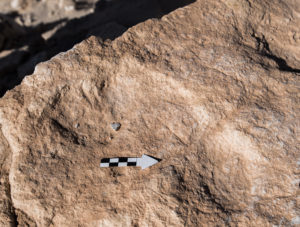
For the first time, an international team of scientists have uncovered fossilized footprints of humans that inhabited the present-day Nefud Desert in Saudi Arabia about 120,000 years ago. The discovery provides evidence for the presence of anatomically modern humans (AMH, or Homo sapiens) in a region suggested by some scientists to have been inhabited during early exodus episodes of humans out of Africa well before the date range thought by archaeologists for the exit (about 60,000 years ago).
Through investigative field efforts led by Mathew Stewart of the Max Planck Institutes for Chemical Ecology (MPI-CE), the research team, consisting of members from MPI-CE and the Science of Human History (MPI-SHH) in Jena, Germany and Royal Holloway University of London, UK, along with other partners, discovered the footprints along with numerous other large mammal footprint tracks in the Alathar ancient paleolake deposit located within the western Nefud desert. The geological deposit, like the desert that surrounds it, has been dry for tens of thousands of years, but at one time it formed the bed of a fresh water lake. The researchers surveyed two sections within a 1.8-meter-thick deposit of sandy-silt diatomite layer, which was overlaid by a layer formed by windblown sand. They uncovered a total of 376 tracks, which included 44 elephant, 107 camel, and 7 hominin footprints. The sediment in which the tracks were found was sandwiched between a younger sediment above and an older sediment below, dating the tracks to a time between 112,00 and 121,000 years ago.
The finding was nothing less than remarkable. “We immediately realized the potential of these findings,” said Stewart. “Footprints are a unique form of fossil evidence in that they provide snapshots in time, typically representing a few hours or days, a resolution we tend not get from other records.” Similar striking snapshots on the spectrum of human evolution have been discovered, for example, at Laetoli in Tanzania and near Happisburgh in the UK.
Other than the human footprints, equally noteworthy were the elephant tracks, as elephants are thought to have gone extinct in the Levant to the west about 400 thousand years ago. According to team member and study author Michael Petraglia of MPI-SHH, the evidence for the presence of large mammals like elephants and water-loving hippos, along with the paleoenvironmental evidence for open grasslands and significant water resources such as lakes in Arabia at this ancient time, likely made the region a desirable place for animals, including humans, to pass through and inhabit as a kind of corridor region between Africa and Eurasia. In the case of Alathar, the findings suggest that the animals and humans were coming together to forage and survive around the ancient lake during a time of increasing aridification (drying) and diminishing water resources. “We know people visited the lake, but the lack of stone tools or evidence of the use of animal carcasses suggests that their visit to the lake was only brief,” says Stewart.
Following the Green
The findings actually represent an event within a larger pattern of environmental fluctuations and animal and human movements over time in the region. “In the present day,” says Ash Parton of the University of Oxford, a specialist on palaeoenvironmental change, “monsoon rains only reach the very south-southwestern edges of the peninsula; however, palaeoclimatic evidence suggests that over the past 130,000 years there have been several periods in which these rains extended all the way into the desert interior. Utilizing a technique that allows researchers to know when individual grains of sand were buried (optically stimulated luminescence dating), findings suggest that the ‘greening of Arabia’ occurred approximately every 22,000 years between around 130,000 and 50,000 years ago. During these times drainage systems became active, leading to the expansion of large meandering rivers and the development of vast freshwater lakes, some of which were up to 2000 km². Palaeoenvironmental evidence from relict lake beds in what are now the hyper-arid Nefud and Rub al Khali deserts of Saudi Arabia, also shows that these large lakes were fringed with grasslands and trees, and home to a wide variety of fauna.”
The Gateway to Eurasia
The species of human that moved through the region during this time period remains a matter of debate. Neanderthals were in Eurasia at the time. But the archaeological record thus far does not support their presence in Arabia during this period, and the record for modern human habitation of the Levant region just to the west dates back to about 180,000 years ago. “It is only after the last interglacial with the return of cooler conditions that we have definitive evidence for Neanderthals moving into the region,” says Stewart. “The footprints, therefore, most likely represent [anatomically modern] humans, or Homo sapiens.”
The footprints are located within what many scientists suggest was a ‘gateway’ between Africa and Eurasia, a possible general route for the dispersal of modern humans out of Africa and into the rest of the world. Although the earliest fossils of AMH discovered outside of Africa date to about 210,000 years ago in southern Greece and 180,000 years ago in the Levant, the exit routes they took from Africa into Eurasia remain largely unknown and a topic of scholarly debate. But it is clear that investigations in Arabia will continue to play a prominent role in the debate. “Every new site being discovered in Arabia reveals remarkable new information which makes it a very exciting time to be working in the area,” said Huw Groucutt, an archaeologist and paleoanthropologist currently with the MPI-SHH who has been conducting research and working at sites in Saudi Arabia for years. “We are confident that……..we will make some major discoveries. We are also keen to see archaeological data emphasized when it seems that many archaeologists have been living in the shadow of genetics interpretations over recent years. Yet archaeological data is the only record of how humans were behaving in particular times and places, so we are trying to restore the balance to the subjects contributing to the story of modern human origins.” Thus the Alathar footprints, maintain Stewart and his colleagues, make an important contribution to the search for early movements of AMH out of Africa into the Eurasian continent.
_______________________________
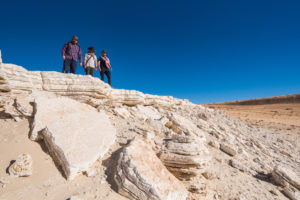
View of the edge of the Alathar ancient lake deposit and surrounding landscape. Klint Janulis
_______________________________
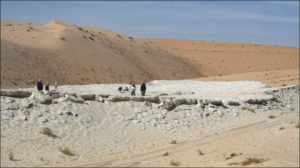
Researchers surveying the Alathar ancient lake deposit. Palaeodeserts Project
_______________________________
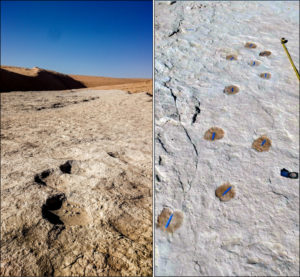
Elephant (left) and camel (right) trackways. Stewart et al., 2020
_______________________________
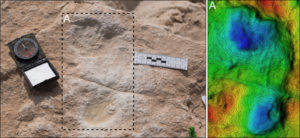
The first human footprint discovered at Alathar and its corresponding digital elevation model (DEM). Stewart et al., 2020
_______________________________

Above and below: First human footprint discovered at the Alathar ancient lake. Klint Janulis
_______________________________
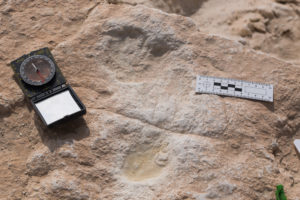
_______________________________
Article sources: SCIENCE ADVANCES and MAX PLANCK INSTITUTE FOR THE SCIENCE OF HUMAN HISTORY press releases, and The First Arabians, published June 5, 2014 in Popular Archaeology Magazine.
_______________________________
If you liked this article, you may like The First Wave, an in-depth premium article now available in the summer issue with a subscription to Popular Archaeology.
_______________________________
Advertisement




